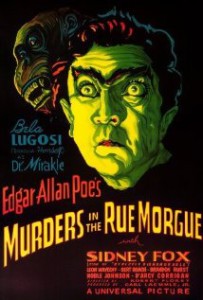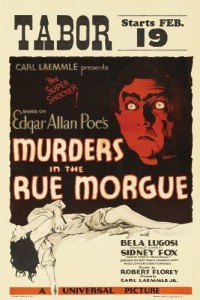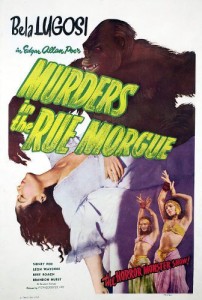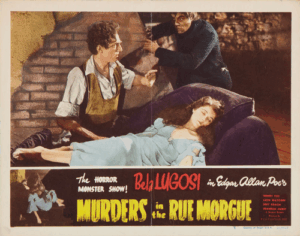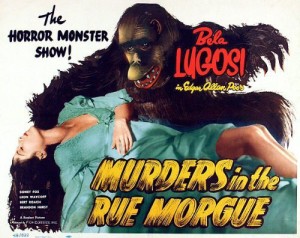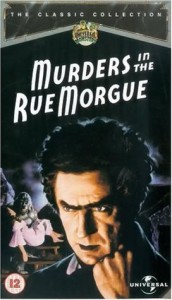Murders in the Rue Morgue **** (1932, Bela Lugosi, Sidney Fox, Leon Ames, Bert Roach, Brandon Hurst) – Classic Movie Review 2,681
Universal Pictures’ vintage 1932 horror movie Murders in the Rue Morgue stars Dracula icon Bela Lugosi as Dr Mirakle, his first role as a mad doctor or scientist.
‘Innocent Beauty – this was her wedding eve. On the wall a shadow… the beast was at large grinning horribly-cruelly. What was Her Fate ?’
Director Robert Florey’s vintage 1932 American Universal Pictures horror movie Murders in the Rue Morgue stars the studio’s great horror icon Bela Lugosi as a mad doctor called Dr Mirakle. After playing the Count in the 1931 Dracula, Dr Mirakle is one of Lugosi’s most important and iconic other turns in the movies.
This bizarrely weird story, distantly derived from Edgar Allan Poe’s 1841 short story The Murders in the Rue Morgue, sees carnival sideshow entertainer and scientist Dr Mirakle travelling to Paris in 1845, looking for a young woman to give his pet ape Erik (Charles Gemora is the man in the monkey suit, though close-ups of a chimpanzee are often used for the gorilla) as a bride and injecting monkey blood into candidates.
Amazingly, the lovely 4′ 11″ Sidney Fox gets top billing over Lugosi in her best-remembered film as Mademoiselle Camille L’Espanaye, the young woman Dr Mirakle and Eric choose. And Leon Ames (then billed as Leon Waycoff) plays medical student Pierre Dupin, her non-simian lover, who discovers what Mirakle is doing too late to prevent the abduction of his girlfriend and calls in the police.
Mirakle has Camille kidnapped and her mother murdered by Erik, and suspicion falls on Pierre Dupin. By some Mirakle, can Pierre save Camille from the clutches of Erik? This leads to a fairly spectacular climax, where the police corner Erik on the roof of a small dockside house and Pierre nips upstairs to try to save his fiancée from peril.
Director Florey’s handling of the tale, which bears little resemblance to the Poe original, though it claims to be based on his ‘immortal classic’, is remarkable. He films in a visually exciting expressionist style similar to that of The Cabinet of Dr Caligari, with eye-catching cinematography by Karl Freund. Each image is a little treasure.
Like the 1931 Dracula, the film’s pacing now seems slack, and some allowances have to be made for the film’s great age, but there is still enough imagination and excitement in the ideas, images, sets and performances to recommend it. It is constantly surprising looking, a brilliantly imaginative fantasy Paris conjured up in a Hollywood studio. There is often a really chilling, always weird horror movie atmosphere, and that’s the other great thing about the movie. It’s a dark, mad world where danger constantly lies.
A commanding Lugosi easily steals the show from the overly dramatic, silent-movie style performance of the top-billed ingénue star Sidney Fox. When Lugosi isn’t on screen, the film is nowhere near as interesting.
Actually, in a good way, the film does have much of the style of a silent movie, reminding us that talkies were still fairly new at the time, with the 30-year-old Leon Ames also giving a silent-movie style performance as Sidney Fox’s distinctly over-aged medical student Pierre Dupin. Lugosi of course is plenty overly dramatic himself, but that is the role, and he relishes it.
There are also some hammy comedy turns to wade through: Bert Roach as Paul, Torben Meyer as The Dane, Agostino Montani as Alberto Montani and Herman Bing as Franz Odenheimer. Happily they don’t have too much to do.
On the other hand there is decent work from Brandon Hurst as Prefect of Police, D’Arcy Corrigan as Morgue Keeper, Noble Johnson as Mirakle’s servant Janos, Arlene Francis as the Streetwalker.
Also in the cast are Bert Roach, Brandon Hurst, Noble Johnson, Arlene Francis, Leon Ames [Leon Waycoff], D’Arcy Corrigan and Betty Ross Clarke.
The screenplay is by Tom Reed, Dale Van Every and a young John Huston, who was working for Universal as a staff writer and is credited for added dialogue, with adaptation by Robert Florey. Much of Poe’s story is changed to give Lugosi his role as Doctor Mirakle. Florey said he ‘had to strengthen and lengthen the Poe short story’ and that he ‘added numerous characters’.
Huston said he had ‘to bring Poe’s prose style into the dialogue’, but the director thought it sounded stilted, so he and his assistants rewrote scenes on the set. As a result ‘the picture was an odd mixture of 19th-century grammarian prose and modern colloquialisms.’
Sidney Fox had just made her Hollywood debut in Universal Pictures’ 1931 film Bad Sister, which was also the debut of Bette Davis. Florey recalled that Davis auditioned for the part of Camille but producer Carl Laemmle Jr rejected her because of ‘a lack of sex appeal’.
Florey first suggested adapting Poe’s story to Universal Studios in March 1930 when Dracula was on release and Frankenstein (1931) was in pre-production, so planning a film of Poe’s story did not begin until 1931 and he was only attached after being taken off Frankenstein and being replaced with James Whale.
During pre-production, Florey quit, arguing with Universal who wanted the film to have a contemporary setting instead of the story’s 19th-century setting, but returned. Filming began on 19 October 1931 and wrapped on 13 November 1931.
Universal had cut the budget of $130,000 to $90,000, but now Frankenstein was a hit so they put the film back into production on 10 December 1931, increased the budget to $186,090 after adding seven days of production for reshoots and new scenes, followed by reordering of scenes in the film’s first half in the editing process.
The film premiered in New York at the RKO-Mayfair Theatre on February 10, 1932, and was released in North America on February 21 censored by US censor boards. Also in the UK, the BBFC made cuts for a ‘A’ rating.
It runs only 62 minutes, though some sources listed it as 75 minutes.
Tchaikovsky’s Swan Lake Overture is played during the opening credits, as in Dracula (1931), but otherwise there is no score.
It was remade as Phantom of the Rue Morgue in 1954, and twice later under this title as Murders in the Rue Morgue in 1971 and The Murders in the Rue Morgue in 1986. Charles Gemora reappears (uncredited) as Sultan the Gorilla in Phantom of the Rue Morgue.
It is the first film to have Lugosi in a role of mad scientist or doctor, roles he reprised in The Black Cat (1934), The Phantom Creeps (1939), The Devil Bat (1940), The Corpse Vanishes (1942), The Ape Man (1943), Return of the Ape Man (1944), Mother Riley Meets the Vampire (1952) and Bride of the Monster (1955).
Florey left Universal and signed to Warner Bros. He made only one more feature-length horror film, The Beast With Five Fingers (1946).
Sidney Fox (born Sarah Liefer; December 10, 1907 – November 15, 1942)
When work offers suddenly stopped for Sidney Fox in 1934, illness and depression set in, not helped by her unhappy marriage. On the morning of November 15 1942, the 34-year-old actress was found dead in her Beverly Hills bedroom by her husband after consuming a fatal number of sleeping pills.
Studio executive Carl Laemmle Jr discovered Sidney Fox in 1930 while she was appearing in the Broadway production of Lost Sheep at the Selwyn theatre. Fox’s relationship with Laemmle as his mistress for several years was a Hollywood open secret.
The cast
The cast are Bela Lugosi as Dr Mirakle, Sidney Fox as Mademoiselle Camille L’Espanaye, Leon Ames [Leon Waycoff] as Pierre Dupin, Bert Roach as Paul, Betty Ross Clarke as Camille’s mother, Brandon Hurst as Prefect of Police, D’Arcy Corrigan as Morgue Keeper, Noble Johnson as the servant Janos, Arlene Francis as the Streetwalker, Charles Gemora as the sideshow ape Erik, Torben Meyer as The Dane, Agostino Montani as Alberto Montani, Herman Bing as Franz Odenheimer.
© Derek Winnert 2015 Classic Movie Review 2,681
Check out more reviews on http://derekwinnert.com

